For almost a year now whispers of an epic kayaking first descent have swirled through the whitewater community. The mission to Ecuador’s Río Chalupas was rumored to have tested the psyches of some of the world’s best expedition kayakers, but details were closely held pending the release earlier this month of a Teton Gravity Research documentary on the expedition, filmed for the HBO series Edge of the Earth.
The four-episode series takes viewers inside the minds and missions of elite climbers, surfers, skiers and snowboarders, but speaking as a whitewater kayaker, the cinematic reveal of the Río Chalupas expedition is the highlight of the series.
The film follows kayakers Ben Stookesberry, Nouria Newman, and Erik Boomer deep into Ecuador’s vast Llanganates National Park as they attempt the first descent of the Río Chalupas. The river drops some 10,000 feet through a 50-mile gauntlet of boxed-in canyons and roadless jungle, making it one of the steepest and most technical whitewater descents ever attempted.
Not featured in the film but very much part of the expedition are kayaking cinematographers Chris Korbulic and Sandy MacEwan, who somehow kept the cameras dry and rolling as the team confronted thigh-deep mud, near-vertical jungle, bugs, hunger, fatigue and the nagging possibility that a wall of water would catch them midway through a canyon with no exit. The result, now streaming on HBO, is a visceral portrait of an expedition under stress.
It’s the kind of film that leaves you wanting more, so we asked Stookesberry to share his views on the expedition and the documentary.
Adventure Journal: How does the Río Chalupas fit into the pantheon of hard things you’ve done through the years?
Ben Stookesberry: It probably has the top spot. It was less technical than a half-dozen or more other descents I’ve done in the past, but that didn’t necessarily make it any less challenging. It kind of made it more challenging in that it forced us to stay at river level, and we didn’t have any easy outs of just being able to rappel a big section of river.
The highest drop on the whole river was a 40-footer, which with 10,000 feet of gradient is pretty remarkable – especially considering that the top 7,000 feet of gradient all happened in 20 miles. Which makes it literally pencil out to be twice as steep as the Middle Kings. [Or about 44 times as steep as the Grand Canyon – eds]
The film gives the sense that this mission was not just technical and difficult and hard – obviously it was all of those things – but also that it was pretty scary in there. Is that how it felt to you?
All of us, to varying degrees, realized how exposed we were just right off the bat when we were hit with a blizzard. If we didn’t already realize how volatile the weather was, that combination of snow and epically high water was a reminder of what anybody who does an overnighter in Ecuador knows – that there’s a very good chance you’re going to have some kind of high water event, any time of year.
And then added to that, even though we were able to scout the river from a helicopter, they couldn’t hover. So we couldn’t really stop and examine the vertical-walled gorges. All we really knew is they would be almost impossible to completely portage.
So there’s no way out, maybe no way through, and the river could flood at any time?
It wasn’t just that the water is going to come up, but that it could flash. So it was that mixture of not being able to get totally comfortable with that possibility, and then realizing more and more that we couldn’t rely on a helicopter rescue were things to go bad.
On top of that, we were making this for TV. And so we all felt a certain level of obligation, and we were struggling with that obligation: Did we really need to take on the hardest, most dangerous trip for that for that particular goal? There are easier ways to make a film than being locked into the Chalupas with four of your best friends where the helicopter can’t get you. All they can do is drop you hot empanadas from the street corner.
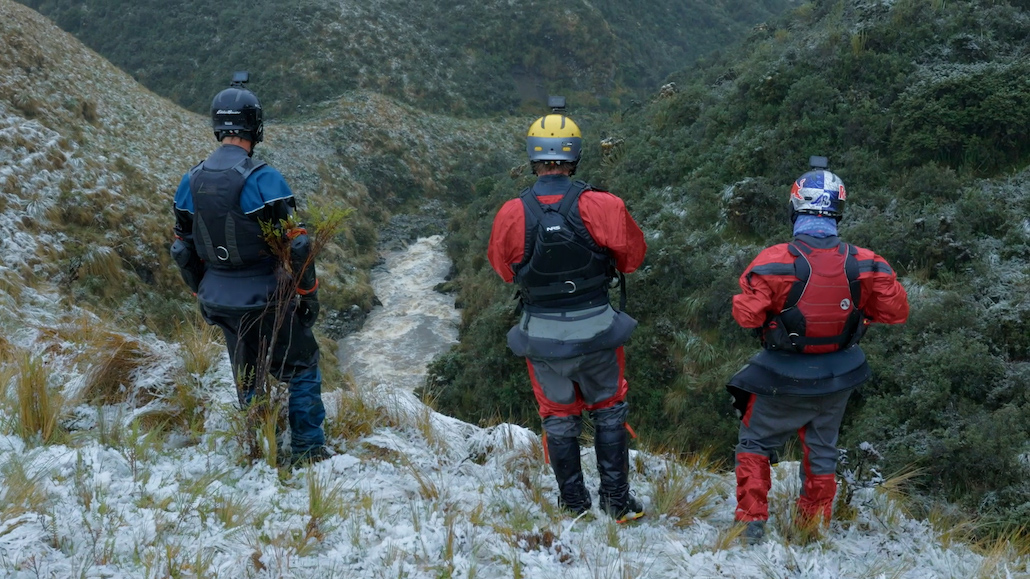
The team surveys the swollen river after a freak snowstorm forced the first of many delays.
Did they actually get empanadas from the street and drop them?
Yes, from Super Pollo in downtown Tena [Ecuador’s whitewater Mecca – eds]. It’s so good, especially when you’re that hungry.
Without giving away too much, you needed the resupply because the section you thought should take eight or nine days took nearly a month.
Watching the film, it says we’re seven days behind schedule or we’re a month behind schedule. It was more like here we are on day 25 or day 30, and we’re still locked into Class V+ or Class VI boating every single day without any real choice of stopping. And that becomes kind of a shitty place, especially when your heart’s not 100 percent into it. If you’re totally passionate about it and this is the one thing that you want to accomplish in life, those trade-offs make sense. But when you’re out there just making a TV show and you’re not 100 percent dialed into pulling this thing off, the group dynamics and group cohesion can erode so quickly.
More so than any other trip I’ve been a part of it caused that schism in the group. And I think having two cinematographers and three people that were featured just created a natural schism in the group. Inevitably Chris and Sandy were going to have to stay up later to recharge batteries and do media management. And from my own point of view, to be a featured part of the film is a bit of an incentive.
There were five of you on the river, but in the film it’s presented as a three-person team.
It focused on the three of us, but they certainly don’t fall over backwards to exclude Chris and Sandy’s presence.
They weren’t hidden, but the emphasis was on the three of you and especially the dynamics between you and Nouria. Without giving away too much, there’s a scene where the three of you were discussing whether to keep going downriver or try to get out. And it seemed that Nouria was stepping into a leadership role and saying, ‘I don’t care what you guys say, I am out of here. I’m done.’
I felt like the film exposed somewhat of an unsavory side of me, and I know that Nouria definitely doesn’t want to be portrayed as someone that was hesitant. They absolutely portrayed her that way in the film, but I think she had something inside of her that was speaking the whole time where the calculation of risk versus reward just wasn’t penciling out.
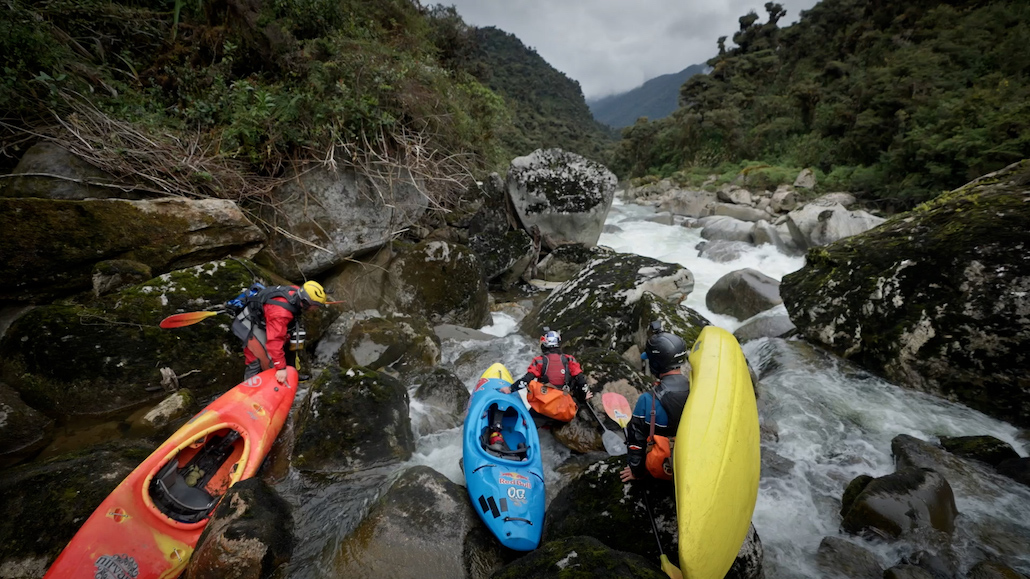
Portaging 100-pound boats around unrunnable rapids ain’t easy.
That scene feels almost like a reality TV confessional, but it works. The film really captures the dynamics of a hard expedition that’s starting to go sideways. There’s a sense of being together in that pressure cooker with your best friends, with people you love, and having it boil over into conflict because you’re under so much stress.
I think that’s what makes this film more approachable than any other project I’ve been a part of in the past, because it does have an element of humanity that’s understandable for even someone who has never been on a river trip before.
It’s effective filmmaking, but everything I know about Nouria – including from you and Boomer and others who have paddled with her – is that she’s the tip of the spear. She doesn’t fit the more cautious or hesitant role that women are so often cast into. That’s just not part of her portfolio.
Something that doesn’t get portrayed enough in the film is that while she’s the one expressing doubt verbally, she’s still leading 60 or 70 percent of the river. She made all the hardest ferries, and she ran more of the river than either Boomer or I. So while she is hesitant about the mission, she’s still performing in the role of the traditional alpha, um, male, I guess. She’s still the alpha dog up until and including the last day.
She does some shit in that river that’s way fucking looser than any of us do. She makes this crazy ass-ferry and runs some V+ stacked right into some Class VI in the middle of this last-chance eddy, and then gets on the other side of the river in order to catch us. And I heard that feedback from her. She’s like, ‘You get to be the asshole and I get to be the weak link.’
Neither is true?
I’m not an asshole all the time. A lot of times I feel like my personality is just trying to make everybody feel as comfortable as possible. At the end of the day it’s a made-for-TV thing, and it definitely did touch on a very important and relatable aspect to all of us river runners, which is small group dynamics.
Boomer called you a cowboy early in the film. What does it say when the guy who dangled over an 80-footer and then cut the rope is calling you bold and a little bit reckless?
He’s maybe seen me a couple of times in person and several times on video be a cowboy. But I think in general, I’m the more cautious of the three for sure. In our time together on the river, I’ve been the one that’s portaged the most. We’ve gone back and forth a bit, but if anybody’s the cowboy it’s probably Nouria. For sure it’s Nouria.
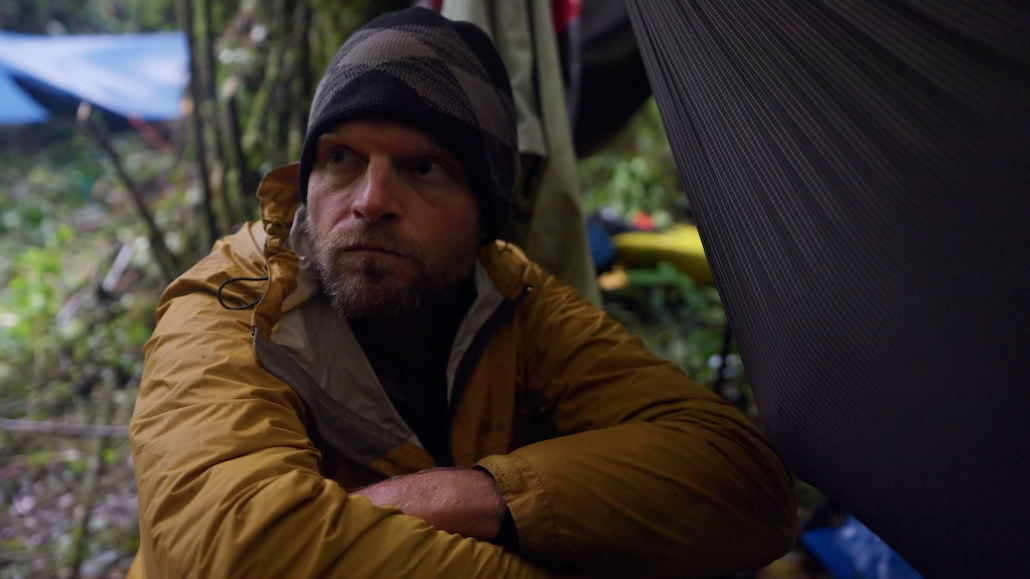
Stookesberry in camp.
Well, Boomer does follow that comment up by saying that in order to find first descents in this day and age, you need a different approach. And if you know the back-story – that you and he pulled sleds all the way across the Greenland ice cap just to run a couple waterfalls on the other side – that approach is to earn it, through a combination of sweat and exposure. That seems like a signature for all three of you.
I don’t think that it’s necessarily any different than exploratory paddling in the past. Think of Walt Blackadar going into the Alsek. That had to be a huge leap of perceived risk, going into that canyon with a .44 Magnum stuffed in a fiberglass kayak. This is just the most recent iteration of that—of having these dream outcomes for a river, and then being able to accept the risk, the work and also the sacrifice. You go in knowing that it’s going to be a struggle, and in some cases that there very much is a huge risk. Certainly the Río Chalupas is that way.
There’s another scene in the movie where Boomer says, ‘You think you’re going to die one minute, and then you don’t. And you appreciate life so much.’ How does that resonate with you?
I can’t imagine there was a time when Boomer ever thought he was going to die. I don’t think enough has been said about how he’s able to stay cool and calm and focused and jovial, no matter how hard it gets.
I have definitely felt that in my own in my own Class V exploratory paddling though. So much anxiety gets built up as you’re coming around a blind corner, and then it all just works out. There’s that sense, this sickening feeling at times, of Is this worth it? It’s like, Why? Why? Why? And then you get to the other side and you have a completely different experience, a completely different take on the situation. So I think that does ring true for me personally. I’m just not sure that’s how it plays out in Boomer’s head. Or maybe he just thinks that’s what a normal person thinks about. He sees that play out in me.
That’s the biggest challenge of starting to grow old into this – trying not to become such a control freak, you know? And I think that played no small part in whatever freakouts I had on the river. I was starting to feel out of control. And in the past I was more oblivious, younger, whatever – it just didn’t bother me nearly as much. More and more as I go out on these expeditions, it’s a struggle just to be okay with the risk. I mean, at some point, either this ends on the river or I decide to stop doing these things. It’s going to happen one of two ways.
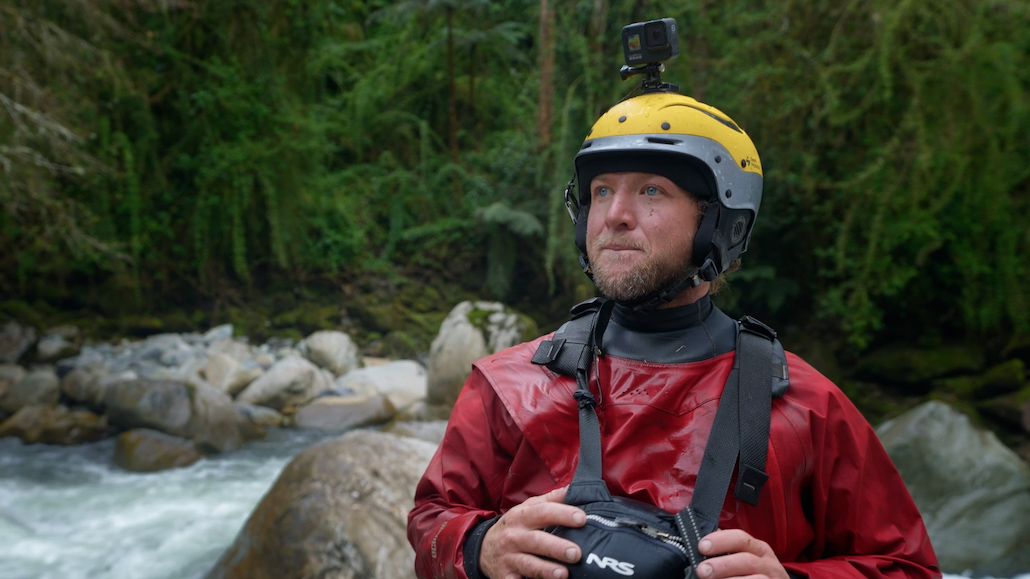
Erik Boomer on the Río Chalupas.
Thinking about trying to finish the Chalupas, I have some pretty mixed emotions. When I’m feeling good and I’m feeling bold and I’m full of endorphins—maybe after a good training session—I’m all into it. And then if I go back and watch the movie again and really think about how it all played out, I’m not so keen.
The film give the impression that you guys rolled snake eyes on conditions, with a historic blizzard to start with and then lots of heavy rain throughout the mission.
With the blizzard at the beginning, we were able to get ourselves off the river and just wait. And in terms of the rain, we got lucky in that we never saw a plus flood in the 22 days we were in there. There was enough rain to keep us off the river several days, almost a week all told, just because we were on such a steep river and we had to have some somewhat of a low flow to even move downstream. But it never came in the middle of the day. We never got caught by surprise in a vertical-walled section of river. So I think maybe we got lucky in that way.
I got the sense from the film that you were the most all-in member of the team, and this is a spoiler alert, but after the five of you finished the upper section and everyone else went home, you went back in. You ran the lower section of the Río Chalupas with an Ecuadorian paddler, Diego Robles. There’s a tag at the end of the film that says you went back, and oh, by the way, suffered a near-fatal machete wound.
To try to encapsulate what went down for the next month and a half or two months after the production ended in two sentences was inevitably going to be sort of an exercise in futility.
I always wanted an Ecuadorian on the team with us because I just thought it was a weird representation to have mostly Americans and a couple of other foreigners come in and be the conquering heroes of this river when there’s such an apt and talented paddling community there. So I was just so stoked to go back in with Diego. He grew up alongside the river, has a spiritual connection to the place and is doing good work teaching indigenous kids who live on the on the banks of the river to paddle.
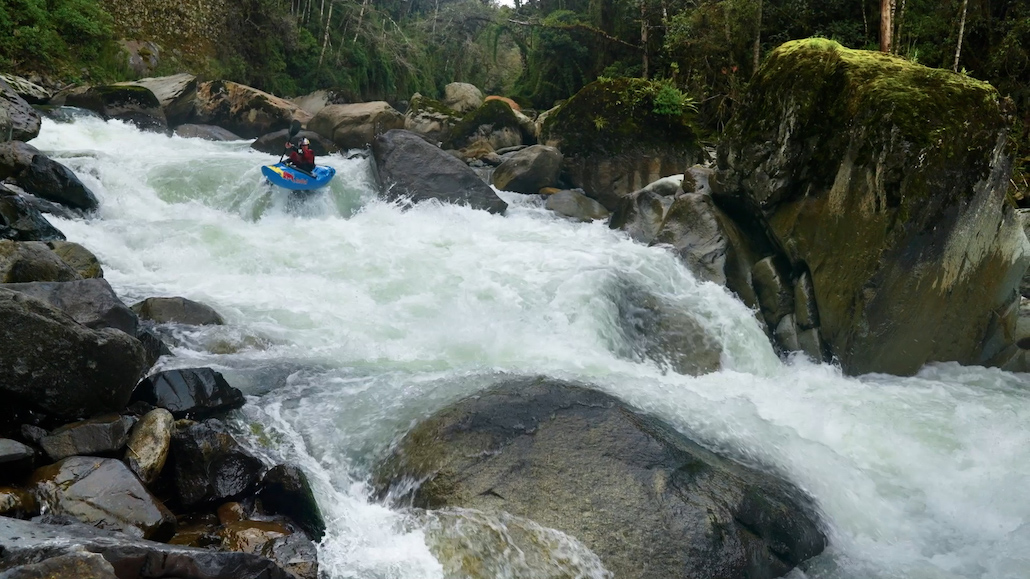
Newman questioned the decision-making, but led most of the hard whitewater.
But near-death?
That has to be some kind of hyperbole, for sure. It was very close to my patella. If I would have chopped a centimeter to the to the left, I would have severed my patellar tendon, and then I would have been at the mercy of potentially getting some crazy military rescue, if they would have been able to pull that off. But that particular wording was a bit of hyperbole. You know, I was bleeding like a motherfucker but I didn’t have to have any blood transfusions when I got out of the river. I didn’t push too hard for them to change the semantics though. In the real world, if you get a two-inch deep gash on your knee it’s not a big deal, but out there when you have to hike over a mountain and rappel down a canyon – who knows what would have happened if that hadn’t worked out.
The machete wound happened below the confluence with the Río Verdeyacu, so between the two expeditions you ran the entire Río Chalupa, albeit with helicopter support and a break in the middle. Would you go back and try to do it again, top-to-bottom?
The dream would be to pull that off. Especially having the map, because a lot of the hard part—just the sheer unknown of it—is out of the equation now. The river is runnable given the right conditions and being able to properly wait for those conditions.
I think it’ll happen with someone. That was one thing I was really stoked about with the two sentences trying to encapsulate what came after the production. Diego’s name goes up there at the end when people are kind of hanging on the edge of their seats, and he gets some shine.
The best-case scenario for me is that’s an encouragement, some motivation for local paddlers to do their own exploration and feel like they could dedicate their lives to the river and have some reward from it.
All photos by Chris Korbulic and Sandy MacEwan, courtesy HBO

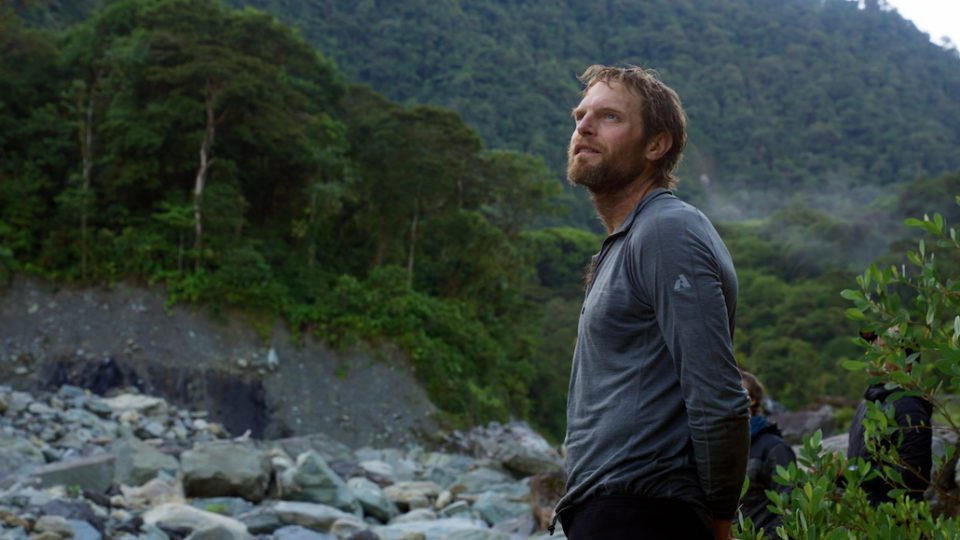
2 comments
Hi there, I found your web site via Google while searching for a related topic, your site came up, it looks good. I’ve bookmarked it in my google bookmarks.
You are my inspiration , I have few web logs and occasionally run out from to post : (.